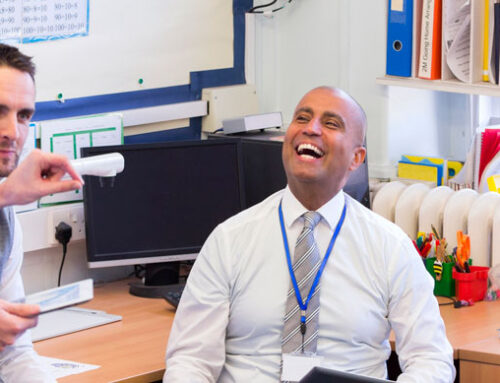Out of necessity, many schools moved to virtual faculty meetings in 2020 and 2021. While this format provides challenges, it also has its strengths. What are the pros and cons of virtual vs. in-person staff meetings? Below we compare both in-person and virtual meeting settings, looking at the opportunities and obstacles that each option provides. This may help your school when making decisions about the types of meetings that will be best for staff.
Virtual Meetings: Advantages
Faculty meetings held over Zoom or Google Meet allow more flexibility for all participants. They are more efficient in that they can begin and end on time. There’s no need to rearrange furniture or scramble from the last class period or bus dismissal. If someone has an emergency and needs to leave right after school or during a meeting, that person can still attend by logging in through a phone app. Virtual meetings are also an easy way to disseminate information, whether through the chat window or by sharing one’s screen. Small groups are simple to create with various break-out room options. Questions and comments are easier to keep track of through the chat feature, which the facilitator can revisit to ensure all unanswered concerns are addressed at a later date. Virtual meetings also allow for fewer side conversations, disruptions, and distractions. Faculty members are being trusted as professionals; they must choose to focus, participate, and not work on something else. It’s less like a classroom, with the facilitator (often an administrator) acting as the teacher and the other educators acting as students. And while this often surprises non-educators, teachers who are comfortable and confident in the classroom may freeze when it comes to speaking in front of a large group of adults. A virtual setting may encourage more participation from those who usually allow the same few voices to dominate a meeting.
Virtual Meetings: Disadvantages
As with anything, some people may take advantage of the virtual meeting setting to complete other tasks. As much as we want to always give professionals the benefit of the doubt, the truth is that there are always those who will look for an out. Virtual settings can also contribute to a feeling of disconnect since faculty meetings are often the only time building-wide staff can meet as a whole group. Being behind a computer screen can inhibit that sense of community. Virtual meetings also allow for more distractions, whether a participant is in the car, in a classroom, or at home. Yes, educators’ time (of which there is never enough) needs to be respected; however, focusing on the task at hand is essential in addressing building concerns. Another potential disadvantage to virtual meetings is that the facilitator may not have the technical skills to run a successful session. It’s even more difficult when that person doesn’t have the opportunity to read body language or pick up on other non-verbal cues. Also, well all know that technology is bound to fail, at least periodically. Wi-Fi, interactive whiteboards, and meeting applications themselves can stop working when we least expect, leaving you further behind in meeting agenda items.
In-Person Meetings: Advantages
One major advantage to meeting in person is the opportunity to create and improve building culture and morale. It allows facilitators and participants to “read the room,” and they will be more likely to share and scaffold upon others’ ideas. It avoids a “Q&A” format and instead allows for a more organic, honest, thoughtful sharing of ideas. In a job that centers around children, colleagues need the opportunity to see and chat with one another. (And if people want to take turns bringing snacks to share, even better!) Great ideas come through true collaboration, and being together can only help. In-person meetings also provide a sense of normalcy in a career that has always been face-to-face. Educators do not enter the field to be sitting behind a desk, staring at a screen. Interpersonal skills are often an educator’s strength and one of the most enjoyable aspects of the job. It’s also effective in welcoming new colleagues into the fold, as they have more opportunities to interact with and get to know their peers.
In-Person Meetings: Disadvantages
In a field that is exhausting for everyone, a meeting can feel like just another thing you have to do at the end of a busy day. Having to rush down to the library, auditorium, or cafeteria for a meeting doesn’t help. It also cuts into valuable meeting time, waiting for everyone to arrive and get settled. Often, unplanned and unpredictable events occur, whether it’s an emergency with a student or at home. In-person meetings don’t allow any flexibility in this case. Just as faculty members can build upon one another’s positive energy, the converse can occur. If the meeting topics happen to be particularly sensitive, for example, participants may feed off of negative sentiments. This can begin to spiral into an unproductive situation.
There is no one right answer, of course, to whether in-person or virtual meetings are better, overall. Your district may even consider a hybrid model where some meetings are virtual, and some are in-person. Virtual options also allow more access to parents, for conferences and back-to-school events. But whatever you end up deciding, taking the positives and negatives of each approach into account will help you arrive at the best decision for your school community.






